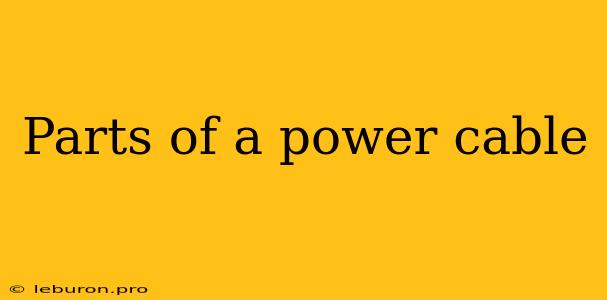Power cables are the unsung heroes of our modern world, silently delivering the electricity that powers our homes, businesses, and infrastructure. They are often taken for granted, but their intricate design and construction are crucial for ensuring safe and reliable power distribution. Understanding the parts of a power cable is essential for anyone working with electricity, whether it's for home repairs, industrial applications, or even simply appreciating the technology that underpins our daily lives. This article will delve into the key components of a power cable and explain how they contribute to its overall function and performance.
The Core of the Cable: The Conductor
The heart of any power cable is its conductor, the material responsible for carrying the electrical current. The conductor is typically made of copper or aluminum, chosen for their excellent electrical conductivity and relatively low cost. The size and type of conductor determine the cable's current carrying capacity (ampacity). Larger diameter conductors can handle higher currents without overheating.
Types of Conductors:
- Solid Conductors: These are made from a single piece of metal and are generally used in smaller cables or applications where flexibility isn't a primary concern.
- Stranded Conductors: These are made from multiple strands of wire twisted together. Stranded conductors offer greater flexibility and are often used in applications where the cable needs to bend or move frequently.
Insulation: Protecting the Current
Surrounding the conductor is the insulation, which acts as a barrier to prevent the electrical current from escaping and causing a short circuit. The insulation material must have high electrical resistance and be able to withstand the voltage levels that the cable is designed to carry.
Insulation Materials:
- PVC (Polyvinyl Chloride): This is a common and cost-effective insulation material that is resistant to chemicals and moisture. It is often used in general-purpose power cables.
- XLPE (Cross-Linked Polyethylene): This is a more durable and temperature-resistant material than PVC, making it suitable for high-voltage and high-temperature applications.
- Teflon: This is a highly resistant material that can withstand extreme temperatures and chemicals, making it ideal for specialized applications.
Shielding: Guarding Against Interference
In some power cables, a shield is added to provide electromagnetic interference (EMI) protection. EMI can cause signal distortion and malfunction in sensitive electronic devices. Shields can be made from a variety of materials, including:
Shield Materials:
- Braided Copper: This is a common shielding material that offers good EMI protection at a reasonable cost.
- Aluminum Foil: This provides excellent EMI protection, but it can be more expensive than braided copper.
- Metal Tape: This is often used in combination with other shielding materials to provide a complete barrier against EMI.
The Outer Jacket: Protection and Identification
The outer jacket is the outermost layer of the power cable and serves several important functions. It protects the inner components from mechanical damage, moisture, and other environmental hazards. The jacket also provides a visual identification of the cable type and its voltage rating.
Jacket Materials:
- PVC: This is a common jacket material that offers good abrasion and weather resistance.
- Nylon: This is a more durable and abrasion-resistant material than PVC, often used in applications where the cable is subjected to heavy wear and tear.
- Thermoplastic Elastomers (TPE): This is a flexible and durable material that is often used in industrial applications.
Understanding the Parts of a Power Cable: Importance
Knowing the parts of a power cable is essential for various reasons:
- Selecting the Right Cable: Understanding the different components helps you choose the right cable for your specific application based on factors like voltage rating, current carrying capacity, environmental conditions, and required protection levels.
- Safety Precautions: Knowing the internal construction of a power cable is crucial for ensuring safe handling and installation. It allows you to identify potentially hazardous situations, such as exposed conductors or damaged insulation.
- Troubleshooting Problems: If you experience issues with a power cable, understanding its components can help you diagnose the problem and determine the appropriate solution.
- Future Technological Advancements: As technology evolves, understanding the fundamental principles of cable construction can enable you to appreciate new innovations and advancements in power cable design.
Conclusion
The parts of a power cable may seem simple at first glance, but they work together in a complex interplay to ensure the safe and reliable transmission of electricity. By understanding the functions of each component, you gain a deeper appreciation for the vital role these seemingly mundane cables play in our modern world. From the conductive core to the protective jacket, each element contributes to the overall performance and reliability of power cables, ensuring that electricity reaches its destination safely and efficiently.
